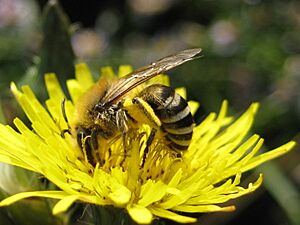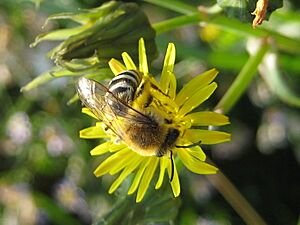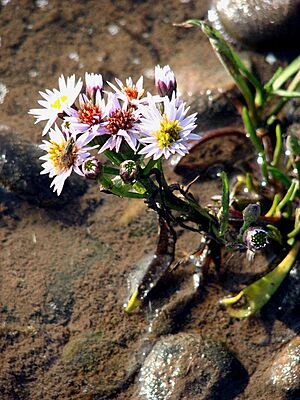Sea aster mining bee facts for kids
Quick facts for kids Sea aster mining bee |
|
|---|---|
 |
|
| Conservation status | |
| Scientific classification |
The Colletes halophilus, also known as the sea aster mining bee, is a special and somewhat rare type of bee. It belongs to a group called mining bees, which are known for digging nests in the ground. You can find these bees living near saltmarshes and other coastal areas in south-eastern England and parts of north-western Europe. This bee faces challenges like rising sea levels and human construction. These issues can reduce the number of sea aster plants (Aster tripolium), which is their main food, and also destroy the places where they build their nests.
Contents
What Does the Sea Aster Mining Bee Look Like?
The Colletes halophilus is a striking bee with a short tongue. Its upper body, called the thorax, is covered in reddish-brown hair. Its lower body, the abdomen, is black with bright, pale whitish to yellow stripes. Female bees are usually bigger and have brighter colors than the males. These bees are about 11 to 14 millimeters long. There are two other bee species in western Europe that look similar: the ivy bee (Colletes hederae) and the common colletes (Colletes succintus). However, these bees live in different places or use different resources, so they don't usually compete with the sea aster mining bee.
Where Do These Bees Live?
The sea aster mining bee has a very specific home range. In coastal eastern England, you can find it from Spurn Point southwards along the east coast, past the Thames Estuary, and along the south coast all the way to Hampshire and eastern Dorset. Outside of England, these bees live in certain coastal areas of western Europe, from the Frisian Islands in the north down to the Bay of Biscay coasts in south-western France.
Where Do Sea Aster Mining Bees Make Their Homes?
Colletes halophilus bees are very connected to saltmarshes. They build their nests at the inner edges of these saltmarshes, where the highest tides usually cannot reach. These nesting spots are also close to their food sources. The bees often choose bare, sandy soil for their nests because these areas get warmer from the sun, especially on south-facing slopes. Besides natural places, these bees also use areas created by humans, like old industrial sites, sea walls, and even piles of sand.
Life Cycle and Habits of the Sea Aster Mining Bee
Colletes halophilus are known as "solitary bees." This means each female bee builds her own nest and raises her young by herself. However, they often build their nests very close to each other, forming large groups that can sometimes include thousands of nests! They dig their nests in bare soil, like areas where plants have been removed by landslides, in soil heaps, or even near European rabbit burrows.
Their nesting sites are at the edge of saltmarshes. Sometimes, during the very highest spring tides, these areas might get flooded. Interestingly, bees have been seen coming out of mud that was recently underwater! Each female bee digs her own burrow. This burrow is usually short and curved, ending in a cluster of about half a dozen cells. These cells spread out from the end of the main tunnel. Male bees sometimes gather together to rest, with as many as a dozen males resting on grass stems.
These bees become active in late summer, sometimes as early as July. The males usually emerge first. They stay near where they hatched, looking for females to mate with. When a female bee emerges, many males will swarm around her, trying to mate. They might even form a "mating ball" with several males surrounding one female.
After mating, the female bees start digging their burrows. They line the inside walls of their burrows with a special liquid that hardens. This hardened lining helps protect the nest from fungus. Each cell in the nest is filled with pollen and nectar. The bees collect most of this food from the flowers of the sea aster plant. The timing of the bee's flight period matches when the sea aster flowers are blooming.
The sea aster mining bee is a univoltine species, meaning it has only one generation per year. The adult bees emerge in late summer. They then lay eggs, and the young bees spend the winter inside their natal cells (the cells where they were born). They emerge the following summer as adults to start the life cycle all over again.
These bees feed on a limited number of plants, mostly from the Asteraceae family, which includes the sea aster. They also eat from plants like weld (Reseda luteola), but sea aster is especially important for them. Both male and female bees need to eat pollen to have enough energy to fly. It's important that their nesting groups are located close to places where they can find food.
The sea aster mining bee can be affected by other insects. A type of cuckoo bee called Epeolus variegatus is a parasite. It takes over the nests of the mining bee, including the food stored inside. This cuckoo bee emerges at the same time as the Colletes halophilus bee. Another parasite is a type of flesh fly called Miltogramma punctata . This fly has been found in the nests of Colletes halophilus and seen flying around the nest entrances.
Protecting the Sea Aster Mining Bee
The Colletes halophilus bee is classified as "Near Threatened" by the International Union for Conservation of Nature and the European Commission. This means it could become endangered in the future if we don't protect it. It's also listed as important in Great Britain and on the National Red List in Germany.
The total number of these bees is small, and they live in separate, spread-out groups. These groups are threatened by things like habitat destruction (when their homes are destroyed), coastal management (changes made to coastal areas), and new buildings or roads being built in their habitat. Rising sea levels caused by climate change might also be a threat. Luckily, these bees do live in some protected areas.
Since C. halophilus bees are willing to use places made by humans, we can help them by creating suitable nesting sites. For example, one of the largest groups of these bees in England lives in an old yard where sand and gravel were stored. The bees nest in a large, artificial mound of sand there. Even on a smaller scale, people who manage land can help by cutting vegetation very short to create bare patches of soil near food sources. This gives the bees places to nest. In one case, bare areas of soil were scraped out between rows of asters, and bees soon moved in. On a larger scale, bulldozers have even been used to clear soil of vegetation to create nesting spots.
Images for kids





